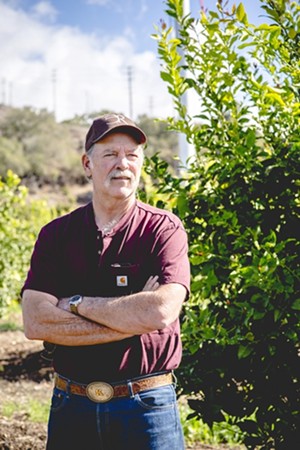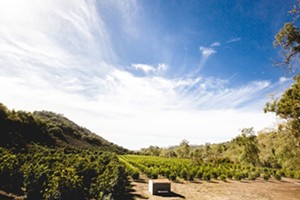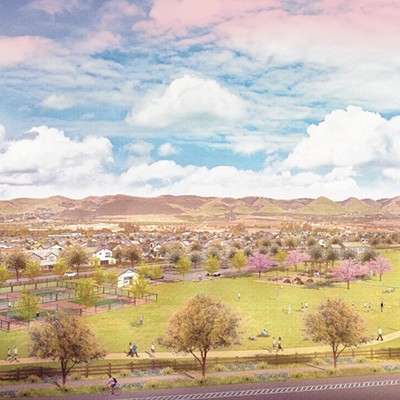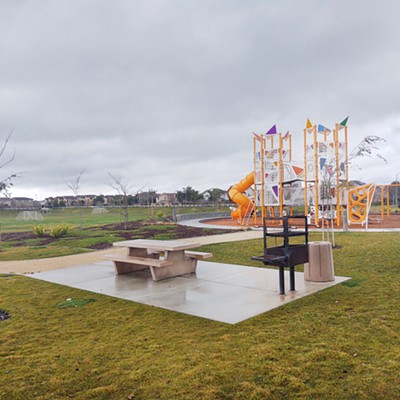The sound of a footstep is muffled in the soft, rain-dampened soil behind the Ellwood Ranch office. With each step, my boots sink into the dark-brown dirt, still wet from 2 inches of fresh rain. Groves of trees stretch out on all sides, and the Feb. 27 morning sun releases the scent of fresh mulch as water begins to evaporate.
Small round oranges interlace with green leaves. Across the road, lemons do the same. Young avocado trees populate the slope of a hill above the valley. Ranch owner Ken Doty sits on the tailgate of his gray Chevy pickup truck with his arms crossed.
He leans back against the side of the truck bed as he speaks in what can only be described as a low, laid-back California drawl. It’s easy to listen to, and he tells me that he’s only taken one week off from irrigating his trees since March 2013.
“If it starts to rain, I might be naked, dancing in the streets,” he told me on the phone the day before.
But he’s not getting nude just yet; he said we need at least 15 more inches of rain to make up for the lackluster rain year. It’s really been a no-rain year, except for recently. And while more rain fell over the first weekend in March, the grand total still isn’t high enough to make Doty feel comfortable enough to take his clothes off.
Living off wells

In a normal year, the ranch typically gets 18 inches of rainfall, but that average isn’t the same across every acre of the property. Less rain accumulates in the orchard closest to Goleta, and more inches fall as the groves reach the western slopes of the Santa Ynez Mountains. The story’s similar for the water that underlies much of the property.
The location and volume of the liquid depends on the geology of rock formations—and those formations differ depending on where you’re standing. Doty said the water basin beneath those roots isn’t like the aquifers of the Midwest, where one single gigantic bathtub of an aquifer can stretch for square miles on end; it’s more like pockets of water interspersed within the rock formations under his property.
Thirsty lemon, avocado, and orange trees are quenched by 11 or 12 wells drilled throughout the Doty family’s property. He said he’s never pumped a well dry before, although he has been forced to limit how much water he pulls out of them.
As we sit on the tailgate and talk, the sun climbs, and the cool from last night’s rain starts to wear off. He squints through sunglasses across to the treetops of a lemon grove planted in 2004. A gray moustache descends down to his chin and around the corners of his mouth. He’s matter-of-fact about the water situation, but his mustachioed face grimaces as he talks about continuing to irrigate.
In a year of average rainfall, irrigating is generally full-bore during the summer months. This means watering 90 acres of avocado trees about once a week and 160 acres of lemons once every 10 days. The watering schedule is usually cut back from mid-October or early-November to March or April, giving water supplies a break and allowing time for a recharge. This year, Doty’s groundwater hasn’t had a break from use or the rain it needs to recharge.
“I’m frankly scared to death that we’ll have some well failure,” Doty said. “We’ll have a little bit of a respite here with the rain.”
He guesses the water pumps will get about three weeks of reprieve, but if the wind blows too hard or the temperature gets too hot, that break from irrigating will get shorter.
He can remember having years similar to this one in the late 1980s, when the officials shut down his water supply. Ellwood Ranch pulls the majority of its water from underground coffers, but Doty said he does take a small allocation of water from the Goleta Water District, which nabs water out of Lake Cachuma Reservoir.
The reservoir is partially dependent on rainfall, but also takes in water from the State Water Project, which supplies it throughout the state—especially in Southern California—via a series of pipelines and canals. One of the most visible links in the state water supply chain is the canal that runs along Interstate 5 in the Central Valley. This year, for the first time since its inception, the State Water Project announced it wouldn’t be making allocations to the 29 districts that receive water through the project.
Doty said this is a real issue for his Central Valley counterparts, who are almost 100 percent reliant on state water to keep their orchards alive. He recently attended a meeting with Central Valley citrus growers who are in the process of trying to figure out what to do with trees that fully depend on rain falling from the sky this year.
“Many of them are pulling [orchards] out or simply leaving them to die,” He said. “At the moment, I feel fortunate that we are not yet in that position.”
Geographical thirst

Santa Barbara County’s water situation isn’t as dire as the Central Valley’s—but, then again, your perspective really depends on where you are in the county. Although the National Drought Monitor lumps the county in the same “exceptional drought” category as the Central Valley, large water basins run beneath much of Northern Santa Barbara County. So while North County’s municipalities do pull a large percentage of their water supplies from state water, they aren’t wholly dependent on the system.
Take, for example, the city of Santa Maria: Typically, the city blends state water 50/50 with water from the groundwater basin before serving it to customers. Now that blend will be 95 percent from the groundwater basin and 5 percent from the state, according to Lisa Long, the business services manager for the city’s utilities department.
“The city of Santa Maria is doing just fine,” Long said. “And it’s largely due to the fact that our residents conserve already, even though they don’t have to.”
Long said there’s plenty of water for residents and growers to use. Some farmers say the basin that underlies the valley has enough water in it to fulfill water needs for another 20 years, even without another drop of rain. Santa Maria isn’t getting 100 percent of its water from the basin because there is some state water leftover from last year. Because the county didn't consume its full allocation of water in 2013, around 13,600 acre-feet of state water is available as carry over for water districts to use. Some of that water will go to North County districts, and some of it will head south via Lake Cachuma.
South County’s water outlook isn’t quite as rosy as North County’s. Municipalities in that region depend on Lake Cachuma to fulfill the majority of their water needs because their basins aren’t as stout as those north of the reservoir.
In a press event held at Lake Cachuma on Feb. 14, county agencies used the microphone set up at the boat launch to proffer a unanimous message: Conserve now, so there’s water left later. It was hot, and sweat started to form on my back as I listened to the speakers.
Cachuma is beautiful in a desperate sort of way. The lake’s blue sheen is stark against the layers of silt that rise above it, etching the hillside with visible measures of water levels past. The boat launch currently leads to cracked dirt, and the floating boat docks are so far away, it’s difficult to make out the faces of people standing on them.
Cachuma Operations and Maintenance Board Manager Randall Ward hung around after the event. He’s a tall, good-natured, and witty man, who volunteered to show me around the lake’s recently exposed bottom. He told me that the last time the lake was this low was in the late 1980s. In 2011, the water in Cachuma breached the top of the spillway at more than 195,000 acre-feet of water, but now it sits at approximately 76,000 acre-feet. In more understandable terms, that’s almost two years’ worth of water.
“We have to make this water supply last for as long as we can,” Ward said. “We need to make it to the next big storm. We don’t know when; we just have to get from now to then.”
A concrete reminder of a road built in the 1930s is now partially exposed on the dry lake bottom. It’s a bouncy ride from the boat ramp to where the road finally disappears back into the water, and at the path’s end, Ward points out a tower that contains a series of five gates that are gravity fed. Water runs from the reservoir, through the gates, and into a tunnel that takes the supply to South County. If the lake gets below a certain level, this system will no longer work. Luckily, the board has a contingency plan in place.
At its Feb. 24 meeting, the maintenance board approved a request to ask for bids on an emergency pumping project for the lake. The project would place a floating pump in the water offshore from where the exposed road drops back into the lake.
The early March storms brought a little more than 7 inches of water with them, according to a rain gauge at the lake, adding approximately 700-acre feet of water to its level.
“We have some inflow,” Ward told me on March 3. “But nowhere near what we need to call off this project. … We need three or four storms like this last one to make up for it.”
He said the county’s so dry that the ground is soaking up all the water it can get, not leaving much room for runoff to hit the lake.
Ward said he’s hoping to get help paying for the pump from a $687-million drought relief package signed by Gov. Jerry Brown on March 1. The money is earmarked for infrastructure improvements, emergency water shortages, and farm-worker aid. Lisa Gardiner, a spokesperson for state Sen. Hannah-Beth Jackson (D-Santa Barbara), said most of the money would be awarded through a competitive grant application process, so it’s unclear where the funds will go just yet.
Gardiner added that the senator is keeping an eye on the Cachuma project as one of the items toward which to try to push relief money.
Finding additional water

With water supplies barely replenished by a storm that brought the county’s average rainfall up to 46 percent of normal, and the near end of the rainy season, how will the county find additional water sources?
That’s a question without a definitive answer.
The agency that brings state water to Santa Barbara County—the Central Coast Water Authority (CCWA)—is finishing up the details on a contract with a water broker, the Sierra Water Group. Ray Stokes, executive director for CCWA, said the infrastructure already in place to convey state water through pipelines and Lake Cachuma is ideal for bringing water to the Central Coast.
Getting water from sources south of the Sacramento Delta could cost the water authority and the districts it serves anywhere from $1,000 to $2,000 an acre-foot of water. Santa Barbara, Goleta, and Santa Maria are just three of eight municipal water districts in Santa Barbara County that use state water through the CCWA.
In addition to buying brokered water through the water authority, the city of Santa Barbara is looking into what it would take to get its desalination plant running again. The plant was completed in the early 1990s as a response to drought conditions and a lack of water. Once water supplies ramped up again, the plant went idle. Kelly Dyer, a water supply analyst from the city of Santa Barbara, said a study from 2009 estimated it would take $20 million to get the plant up to par.
She said it costs $1,500 for the plant to produce one acre-foot of water; that’s 15 times what the city pays for Lake Cachuma water.
In the case of lemon growers in South County, such as Ellwood Ranch’s Doty, the option is to dowse for a place to drill another well—or hire someone else to do it. Three months ago, Doty got on the waiting list to drill a new well through A and A Pump and Well Service in Buellton. He said the company is scheduled to visit the ranch sometime in June.
Richard Alexander with A and A Pump and Well said the company is so busy with requests to drill new wells that projects are now a year out. But he added that demand would die down a little if the rain continues, because people won’t feel the same sense of urgency they do now.
Searching for a new spot from which to pull water is going to cost Doty between $30,000 and $40,000, and that doesn’t include the well equipment or piping. At the moment, he’s trying to stretch the current water supply as far as he can.
In February, Doty hauled in truckloads of mulch he bought from the county. Mulch will help keep moisture in the ground and add nutrients into the soil as it breaks down.
So far the drought’s effect on Doty’s lemons has shown itself in the size of the fruit he’s harvesting; it’s smaller than it should be. That’s a real issue for Doty, considering the first thing you see as you walk into his office is a sign on the wall that reads “SIZE ALWAYS MATTERS” with an avocado engraved on one side and a lemon on the other.
He said everything is coming together in perfect harmony except for the rain. The price on the market is good, his trees are in their prime—both avocado and lemon—but without water, he doesn’t know if Ellwood Ranch can have the banner year that’s penciled out.
“And we don’t know what the effects of the drought will be on next year’s crop,” he said.
He leans back in his office chair and muses about trying to keep the orchard in the family. He said he’s been working with his 36-year-old son, whom he hopes will take over orchard operations in the future. Above his head on the wall are the Doty family patriarchs; most memorable to him are his father and grandfather, who passed their love of the produce business on to him. Ellwood Ranch has been in the family since 1921.
“We’ve been through the whole gamut of crops that can be grown here, which is huge … but lemons have always been a constant,” Doty said. “Lemons, God bless ’em, always grow fruit. Avocados, you look at them cross-eyed and they whine and cry.”
He has a brother who opted out of the produce-making business. Doty laughs as he tells a story about when his brother was 2 years old and was found at one of the edges of the property, hanging from a barbed wire fence by his diaper.
“My brother took off for the horizon when he was 2 years old. I think he’s still looking for the horizon. I couldn’t think of anywhere else I’d rather be,” Doty said.
Contact Staff Writer Camillia Lanham at [email protected].













